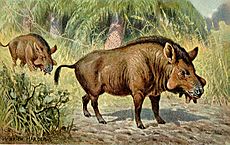Entelodont facts for kids
Quick facts for kids Entelodonts |
|
|---|---|
 |
|
| Illustration of Entelodon | |
| Scientific classification | |
| Kingdom: | |
| Phylum: | |
| Class: | |
| Order: | |
| Suborder: | |
| Superfamily: |
†Entelodontoidea
|
| Family: |
†Entelodontidae
Lydekker, 1883
|
Entelodonts were a group of ancient mammals that looked a lot like giant, scary pigs! They lived a very long time ago, spreading across forests in North America, Europe, and Asia.
These amazing animals thrived for about 20 million years. They appeared during the middle Eocene epoch and disappeared by the early Miocene epoch. Scientists believe they ate many different things. Some were omnivores (eating both plants and meat), some were carnivores (eating only meat), and others were scavengers (eating dead animals).
Contents
What Were Entelodonts?
Entelodonts were part of a family called Entelodontidae. They are sometimes called "hell pigs" or "terminator pigs" because of their fierce looks. Even though they looked like pigs, they were not direct ancestors of modern pigs. They were more closely related to hippos and whales!
Their Appearance
Entelodonts were very large and powerful animals. Some species could be as tall as 6 feet (1.8 meters) at the shoulder. They had long legs and a strong body. Their most striking features were their huge heads and powerful jaws.
Unique Facial Features
Their skulls were very distinctive. They had bony bumps and growths on their faces. These bumps might have protected their faces during fights. They also had large, sharp teeth, including big tusks. These teeth were perfect for tearing meat and crushing bones.
When and Where Entelodonts Lived
Entelodonts lived during a time when Earth's climate was changing. They first appeared about 40 million years ago. This was during the middle Eocene epoch. They continued to live through the Oligocene epoch. They finally died out around 18 million years ago, in the early Miocene epoch.
Their Ancient Habitats
These animals roamed vast forests and woodlands. They were found across different continents. Their fossils have been discovered in North America, Europe, and Asia. This shows they were very successful and widespread creatures.
What Entelodonts Ate
Scientists believe Entelodonts had a varied diet. Their strong jaws and teeth suggest they were powerful hunters and scavengers.
Diet and Hunting Habits
Many Entelodonts were likely omnivores. This means they ate both plants and meat. They might have dug for roots and tubers. They also probably hunted other animals. Their large size and powerful bite would have made them dangerous predators. They could have hunted smaller mammals or even larger prey.
Scavenging Behavior
Entelodonts were also excellent scavengers. Their strong jaws could crush bones to get to the marrow. This was a valuable food source. They might have chased away other predators from their kills. This behavior helped them survive in their ancient environments.
Famous Entelodonts
Several different types of Entelodonts have been discovered. Each had its own unique features.
Archaeotherium
Archaeotherium was one of the earlier and more common Entelodonts. It lived in North America. It was a large animal, similar in size to a modern rhinoceros. Its fossils show its powerful jaws and teeth.
Daeodon
Daeodon was one of the largest Entelodonts. It lived in North America during the early Miocene. It was truly gigantic, standing over 7 feet (2.1 meters) tall at the shoulder. Its huge skull and powerful bite made it a fearsome animal. It was one of the last Entelodonts to exist.
Dinohyus
Dinohyus is another well-known large Entelodont. It is sometimes considered the same as Daeodon. It also had a massive skull and powerful jaws. These animals were at the top of the food chain in their ecosystems.
Why Entelodonts Disappeared
After millions of years, Entelodonts eventually died out. Their extinction happened during the early Miocene epoch.
Possible Reasons for Extinction
Scientists are not entirely sure why Entelodonts disappeared. It might have been due to changes in climate. The world became cooler and drier. This could have changed the types of plants available. It also affected the animals they hunted.
Competition with Other Animals
Another reason could be competition from new predators. Other large carnivores and omnivores appeared around the same time. These new animals might have been better at hunting or finding food. This competition could have led to the decline of the Entelodonts.
Images for kids
See also
 In Spanish: Entelodontos para niños
In Spanish: Entelodontos para niños




